FRIDAY
MAY 31 - 2019
Brook
Meadow - Orchid counts
I went over to
the meadow this afternoon mainly to do another count
of the Orchids, though I kept an eye open for other
things too while I was there. I counted the Orchids in
the main orchid area on the north meadow and on the
Lumley area. I am pleased to say we have beaten last
year's totals for both Southern Marsh Orchids and
Common Spotted Orchids, but only by a very small
number. I will do another count in a week's time, but
I am not optimistic about any big changes as the
Orchids are getting harder to see as the grasses grow
taller.
Here's a nice
Southern Marsh Orchid showing nicely today

Here are the details
of today's counts:
Southern Marsh Orchids: Total 104 (last year's
total was 101). 93 in north meadow and 10 in Lumley
area. I was surprised to find just one Southern Marsh
Orchid deep among the tall grasses on the centre
meadow. The first I have seen in this area.
Common Spotted Orchids: Total 28 (last year's
total was 25). 22 in north meadow and 6 in Lumley
area.
As for the Bee Orchids, we appear to have a
total of 10 recorded, all on the Lumley area and
marked with twigs. Most of them are clearly visible
from the path that goes round the Lumley area. There
are none so far in the north meadow.
Other
observations
Despite the
warm conditions I only saw two butterflies during my
walk. A Small White feeding on a buttercup and
a Comma near the seat. I only managed to get the Small
White.

I saw my first
Banded Demoiselle (a male with a blue band
across its wings) but failed to get a photo.
The first Yorkshire
Fog grass is now out on the centre meadow. This is
an attractive grass with soft velvet like sheaths and
panicles. All you have to do to identify it is run a
sample through your finger. It's so smooth.
I was also pleased to
find Brooklime in flower along the path down to
the Lumley Stream from the Lumley area. It is close to
the small patch of Celery-leaved Buttercup which is
now in flower. The large leaves of Water Dock are
emerging on the near bank of the Lumley Stream. Here's
the Brooklime.
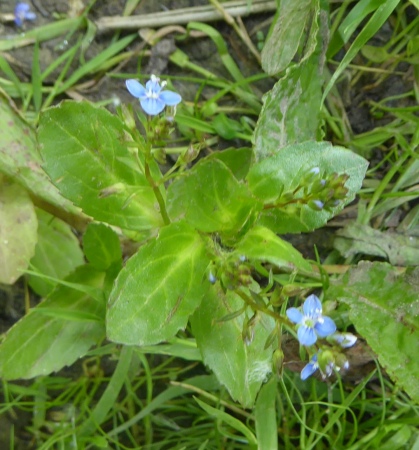
My best find of the
day was a small patch of Hairy Sedge (Carex
hirta) close to the eastern path that crosses the
centre meadow. This is the only sedge with hairy
leaves and sheaths, though the hairs are not always
that easy to see in the field. It has 2-3 male
spikelets at the tip and several distinctive female
spikelets below which are erect and widely spaced with
long leaf-like bracts.

Hairy Sedge is also
distinctive in having long beaked downy fruits. These
are shown well in the sample I collected today. Here
is a fruit that I photographed through my microscope
at 20x magnification.

Hairy Sedge is fairly
common in wet meadows, though I often have a job
finding any on Brook Meadow. However, this year I have
been lucky in finding two good samples both on the
centre meadow.
Hedgehogs
I put the
trail camera out on the patio every evening and
usually record one or two Hedgehogs. Last night I got
a nice photo of the pair close to the camera. I
sprinkle a few mealworms on the ground near the
camera, but am sparing in their use as too many are
not good for the hogs.

Cuckoos
John Curtin
has heard a Cuckoo calling regularly from the Thorney
Little Deeps area morning and evening of May 18th and
19th and then again on the evening of May 23rd and
morning of May 24th and early afternoon May 26th. That
is good news. I would also expect to hear Turtle Dove
in that area, but sadly times have changed. However,
Turtle Dove can still be heard in the Marlpit Lane
area along with Nightingales. Now there's a treat!
Bee
Orchids
Di Ashe has
had a look for the Bee Orchids on the grass verge near
the Warblington roundabout which are marked with a no
cutting notice. Di says they are just about to bloom
but are closer to the drain cover to the left of the
sign nearest to Havant. In previous years we have had
over 60 flowers on this verge now the Council are
aware to avoid cutting the verge at that point. Roy
Eames is now 'in charge' of this verge and I have
asked him to do a count.
Bee Orchid on the
Warblington verge taken a couple of years ago.
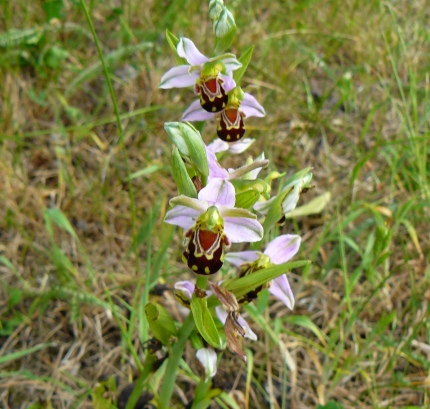
TUESDAY
MAY 28 - 2019
Two
Hedgehogs
I had the
trail camera out on the patio again with a few
mealworms last night. Two Hedgehogs were present for
much of the night from about 10.00pm until it was
getting light at 4.30am. I got some really nice
images, including some close-ups, but no mating - not
on camera at least.
MONDAY
MAY 27 - 2019
Bee
Orchids
Jean and I had
a walk through Brook Meadow this morning mainly to
look for Bee Orchids. We easily found the two Bee
Orchids that Maurice Lillie had marked with twigs
close to the path around the Lumley area. In the same
area Jean spotted two more Bee Orchids in flower which
I marked with twigs. This takes the total so far this
year to 5 including the one I found a few days ago.
Here is one of
the Bee Orchids we found on the Lumley area. Beautiful
flowers.
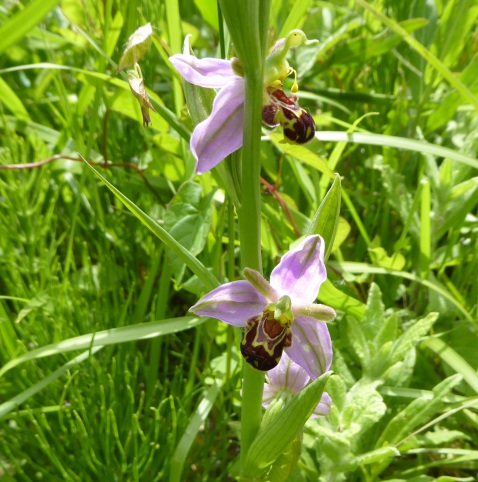
Yesterday afternoon
Jill Stanley went to the Northney reserve and counted
42 Bee Orchids though only a few of them were
beginning to open. Jill thinks there should be a
reasonable showing in about a week.
I would expect the Bee Orchids also to be showing in
other places, including the grass verge near the
Warblington roundabout, which we have been trying to
protect from the council cutters. Has anyone seen them
there?
While she was at
Northney Jill also saw Grass Vetchling, Hairy Tare,
Lesser Stitchwort, Hedgerow Cranesbill and some
Greater Sea-spurrey near the shore.

SUNDAY
MAY 26 - 2019
Brook
Meadow
I went over to
the meadow this afternoon mainly to carry out another
orchid count. The orchid flower spikes are standing up
well, but are still relatively small - due to the dry
weather? They are becoming increasing difficult to see
among the burgeoning grasses.
I counted 76
Southern Marsh Orchids: 61 on the main orchid
area, 5 south of the main orchid area and 10 on the
Lumley area. Last year's total was 102, so we still
have some way to go.
I counted 26 Common
Spotted Orchids: 22 on the northern part of the
main orchid area some pale and some dark and 4 on the
Lumley area. Last year's total was 25 so we have
beaten that already.
Examples of the
pale and dark varieties of Common Spotted Orchids.
I found my first
Bee Orchid of the year on the Lumley area which
I have marked with a twig. Maurice Lillie e-mailed to
say he had found two more Bee Orchids by the north
path which I did not see. That means we have already
equalled last year's total of 3, so let's hope for
more.
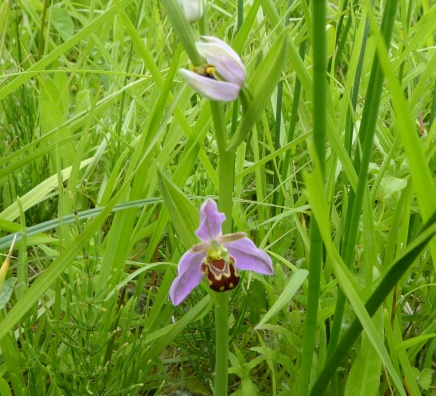
Maurice Lillie
previously alerted me to the presence of 23 flowering
Ragged Robin plants in addition to the 155 I
counted recently on the Lumley area. I confirmed these
new ones and added them to the revised total for the
year which now stands at 178.
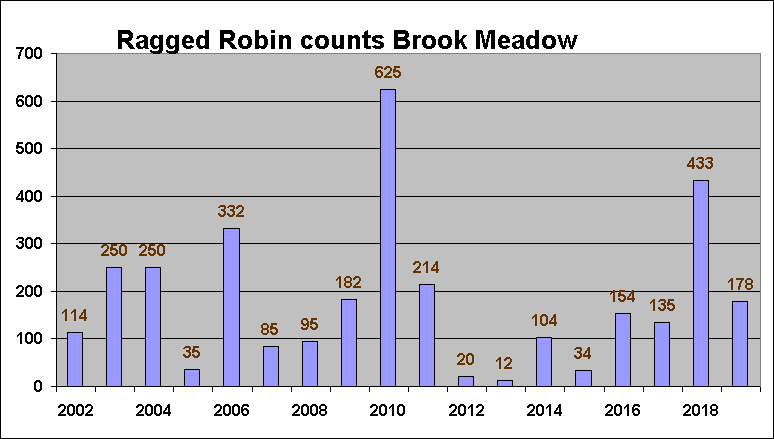
There is a good patch
of Lesser Stitchwort among the tall grasses on
the centre meadow north of the causeway.

The tall Ash
tree on the causeway close to a Hawthorn bush
looks very sickly. It has some leaves, but also many
dead branches. I fear this tree has succumbed to the
Ash die-back disease. Does this need reporting? The
younger Ashes closer to the seat appear to be
unaffected.

Far more pleassant
sight was the first Small Copper butterfly of
the year resting on a panicle of False Oat-grass on
the main river path. We don't see these attractive
little butterflies on Brook Meadow every year. They
lay eggs on Common Sorrel of which there is plenty on
the meadow.
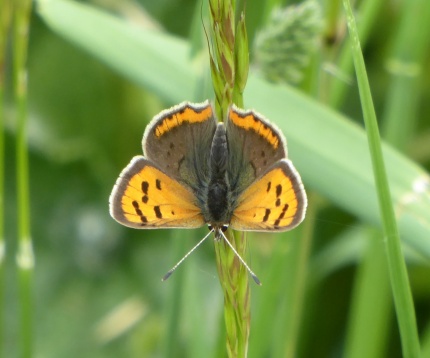
I also had my first
Swollen-thighed Beetle (Oedemera
nobilis) on a Dandelion flower. These will become
very common the meadow as summer progresses. Two pairs
of mating Harlequin Ladybirds on nettles on the
river path.
I saw several fast
running spiders on the Lumley area carrying creamy
white egg cocoons. They are very alert to my approach
and I was lucky to get this photo before it ran away.
They don't look like our common Nursery-web spider
(Pisaura mirabilis). I think they are a species of
Wolf Spider (Pardosa) but species unknown. Help
appreciated.
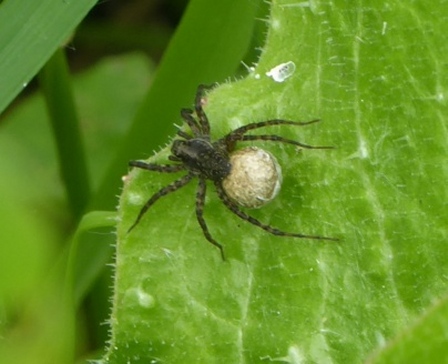
SATURDAY
MAY 25 - 2019
Two
Hedgehogs
The trail
camera picked up two Hedgehogs last night on the patio
cleaning up a few mealworms that I scattered around.
First sighting: 22.13. Last sighting: 04.45. In the
photo on the right they are enjoying a drink of water
from a dish.
This fellow came very
close to the camera.
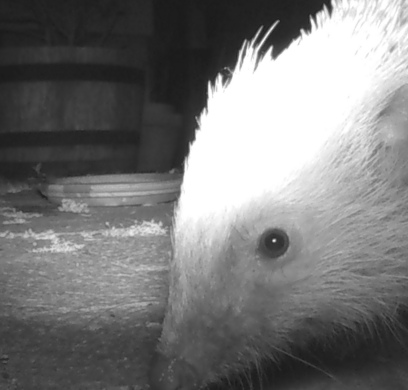
Cuckoo
in Emsworth
Mandy Dridge
heard a Cuckoo this morning at around 7.30 while she
was walking her dog in the Hampshire Farm open space.
That is the first Cuckoo I have had reported and
hopefully it will stay around. Please let me have any
further hearings.
Kingley
Vale
Heather Mills
reported on this morning's walk by the Friends of
Wildlife group.
Six met this morning on a bright morning to search out
the delights of Kingley Vale. Our first encounter was
a singing Yellowhammer with a nearby Common
Whitethroat and singing Chaffinch. We were fortunate
to find a Wren with its juveniles in the hedgerow
calling to be fed. We stopped at a hedge line in the
field to locate another calling Yellowhammer. Before
we had located it Neill saw a female Blackcap dive
into the bushes and luckily this was followed by the
Male which most of us saw. A Dunnock sang on top of
the bush as we found the Yellowhammer had come much
closer.

A large number of
Ladybirds had appeared along the footpath together
with a couple of Small White butterflies and Red
Admirals together with a few Brimstone males and
females and Orange Tip butterflies.

Further along the
White Campion was abundant with a few Red dotted
about, and a good display of White Bryony and
Cut-leaved Cranesbill. Ros also identified Lesser
Stitchwort.
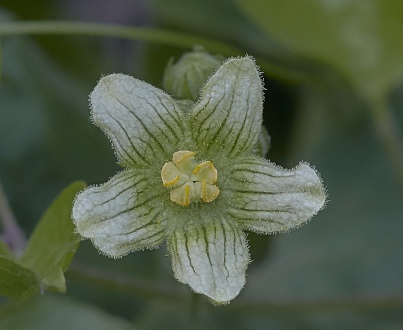
As we proceeded along
the main footpath into the reserve Blackcaps
constantly accompanied us with their singing right
into the reserve entrance.
Stephanie had visited
recently and hoped to be able to show us the
Grizzled skippers. Right on cue a few flew up
and we also had Dingy Skipper and Common Blue
with a Small Copper.
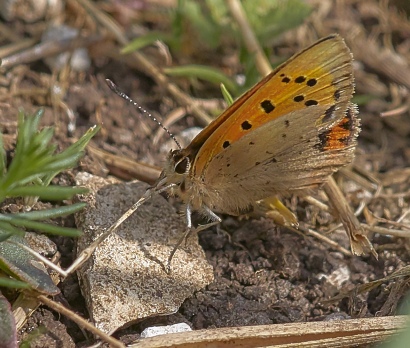
Bullfinch called and
Goldcrest sang with more Yellowhammers as we
progressed. A wonderful sight of a Whitebeam in
glorious blossom attracted a myriad of Red Admirals
and humming bees. A few Yellow Shell Moths flew around
too.
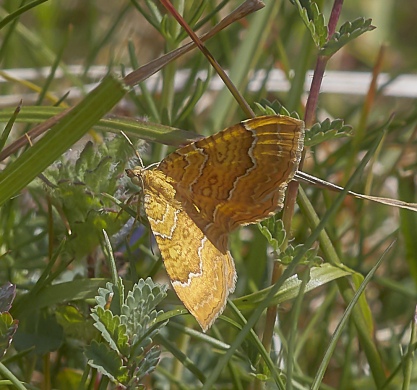
We stopped for coffee
after having inspected the dew pond which
unfortunately had dried up. The most exciting event
was a singing Turtle Dove. We were all thrilled
to hear it. As we returned through the Yew trees a
family of Treecreepers suddenly searched the
trunks for insects. A sight for sore eyes to see these
endearing birds doing well.

Ros pointed out the
Marsh Thistles and I captured a close one but I now
think this is Woolly Thistle.
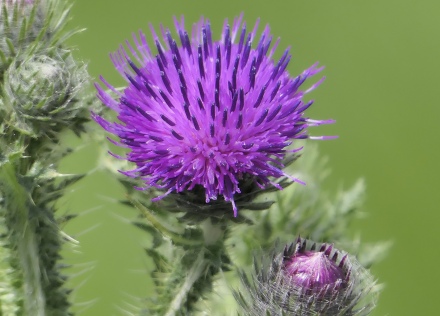
A very pleasant
morning with wonderful surprises.
For more dertails
about this local wildlife group go to . . .
Havant
Wildlife Group
FRIDAY
MAY 24 - 2019
Brook
Meadow
I had a good
look at the riverbanks in the area north of the S-bend
behind the Williams workshops where Roger and Linda
Mills reported seeing a Water Vole a few days ago. I
stayed for about 15 mins, but saw nothing apart from a
bright eyed Moorhen swimming upstream which,
incidentally, reminded me I had not seen any Moorhen
chicks on the river so far this year.
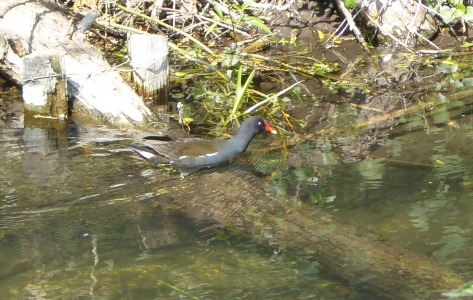
About a month ago
Chris Luna reported seeing what he thought was a Water
Vole in the same area behind the car workshops, but I
am pretty sure that was a Brown Rat which I saw on the
riverbank at that spot the next day. Rats are common
all along the river, but particularly in areas of
human activity.
Today, I was pleased
to make the acquaintance of Peter from Penny Lane in
Southbourne. He said he read my Emsworth wildlife blog
and was appreciative of the efforts of the
conservation group. I encouraged him to send any
observations or pictures for inclusion in the
blog.
While I was on the raised path by the river I heard a
pair of Carrion Crows making a great racket. The cause
of their concern was a Fox which was running across
the meadow towards the bushes on the east side with
something fairly substantial in its mouth. I could not
see what its prey was, but I don't think it was a
young crow as it looked quite pale, possibly a Rabbit,
though they are rare on the meadow.
In view of Michael
Prior's worrying report about the prevalence of Ash
die-back in Stansted Forest I had another look at
the large Ash on the railway embankment which I have
been concerned about. As the photos show, the tree
looks quite good from a distance with lots of leaves.
However, a closer look reveals many dead branches and
a general scarcity of foliage. I suppose the concept
of 'die-back' suggests a gradual death for the tree if
it does have the disease. It is such a huge tree that
it will make an almighty crash if it comes down.
The Hemlock
Water-dropwort in the south meadow are now
developing their large flowerheads called umbels.
There are some fine stands of Yellow Flag (or
Iris) in the south east corner of the south meadow
with several bright yellow flag-shaped flowers from
which the plants get their common name.
I was also pleased to
see a few plants of Sea Club-rush in the south
east corner of the south meadow. These plants, which
despite their common name are actually sedges,
originate from the Hermitage Millponds where they
thrive in the brackish water around the edges of the
ponds. So far this year I have recorded 12 of the 15
sedges on the list, though a couple are not regularly
seen.

I discovered a few
flowering plants of Celery-leaved Buttercup -
with distinctive elongated fruits in the centre of the
flowers - on the casual path down to the Lumley Stream
from the Lumley area. This is a rare plant on the
meadow and only occurs in wet areas.

Today's
orchid count:
Southern Marsh Orchid = 52, including 42 on the
main orchid area and 10 on the Lumley area. Most of
them are still quite small and have more growing to
do. This is the best one I could find.
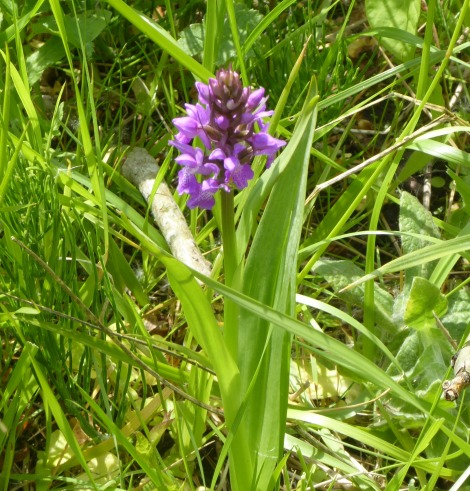
Common Spotted
Orchid = 8 including 4 with pale flowers and 4
with dark flowers. The photos show two pale ones
together and a dark one.
The easiest way to
tell the orchids apart is by their leaves - plain
green in Southern Marsh and dark spotted in the Common
Spotted. If you look closely the flowers also differ;
Common Spotted (left side photo) has wavy lines on the
lobes whereas the Southern Marsh (right side photo)
has spots.
There should be more
orchids appearing in the next couple of weeks, but we
are only half way to last year's record totals of 102
Common Spotted Orchids and 25 Common Spotted Orchids.
Hermitage
Millpond
I had a quick
look at the two millponds. I was surprised to see a
pair of Canada Geese on the centre raft on Slipper
Millpond, but not I think the pair that nested there.
The regular Canada Goose pair was on Peter Pond. The
Mute Swan family with 4 cygnets intact was on Slipper
Millpond near the Hermitage Bridge.
THURSDAY
MAY 23 - 2019
Fort
Cumberland
I had to take
Jean into Southsea this morning, so I took the
opportunity to have a look around some of my old
haunts. Driving along the seafront towards Eastney I
stopped briefly to admire and take a photo of the view
across the Solent to the Isle of Wight with the
shingle beach dotted with bright red bushes of Red
Valerian.

I parked at Fort
Cumberland where, if you know it, the parking surface
used to be full of pot holes. However, the surface is
much improved for a smooth drive. I strolled around
the grassland west of the main fort, but I was really
a bit early for most of the flowers and the ground is
so dry everywhere.
Two Whitethroat were singing from the bushes
and trees. I managed to track this one to the top of a
tall conifer near the caravan park. Even better was to
hear a Greenfinch merrily churring, a rare bird
these days!
Common
Cat's-ear was widespread with also lots of
Beaked Hawk's-beard. The rather delicate
Sheep's Sorrel was also quite widespread. There were
also patches of what must be Mouse-ear Hawkweed
judging by the very furry basal leaves and bracts with
dark glandular hairs.

Eastney
Beach
From Fort
Cumberland I cut through the path to the beach and
walked along the upper path near the fence overlooking
the caravan holiday park as far as the swimming pool.
I noted lots of flowers including masses of Oxford
Ragwort fluttering around which was a bright red
Cinnabar Moth looking for somewhere to lay its eggs.
The very pretty flowers of Field Bindweed were
dotted around the embankment.
Other plants in flower
included Common Mallow, Yellow-horned Poppy, Yarrow,
Buckshorn Plantain and some spectacular displays of
Red Valerian.

There was lots of tall
plants of Sea Radish, mostly with yellow flowers, but
some white. I recall Martin Rand telling me that Sea
Radish often has white flowers near the coast (despite
what the book says).

Speckled
Yellow Moth
Jo Bray sent
me a couple of very hazy photos taken on her phone of
a small yellow/orange 'butterfly' in Southleigh Forest
yesterday that she did not recognise. Jo pored over
her butterfly books but was stumped! She thought it
looked most like a Small Pearl-bordered Fritillary,
but it was a bit small. Maybe she thought it was
actually a day-flying moth...?!

Yes, Jo the insect in
your photo is much too small for a Fritillary
butterfly. You are right it is a day flying moth
called Speckled Yellow Moth. I have often seen
these flying in Hollybank Woods and they are brightly
coloured and do look like small butterflies. Here is a
shot I got of one in Hollybank Woods a few years ago
which shows its main features clearly.
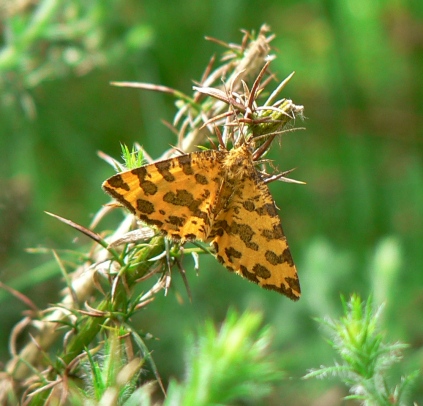
Stoughton
orchids
Maureen Power
went to Inholmes Wood, above Stoughton, yesterday and
found Common Twayblades, Greater Butterfly Orchids and
White Helleborines in flower. She sent photos of the
Twayblade and Greater Butterfly Orchid.
Turtle
Dove at Marlpit
Dave Cuell had
a wander along Marlpit Lane on Wednesday evening 22/5
to see if the Nightingales were still singing...which
they were to his delight! Dave then walked along the
public footpath to the east and heard a Turtle Dove
which was singing for a good half hour. Dave says,
'Hopefully it's there to stay....what a joy!'
Wow! I fully agree. I always used to hear Turtle Dove
in that area and it's wonderful news to know at least
one is back. Has anyone heard a Turtle Dove down on
North Thorney? That was also another popular spot to
hear them in the past.
I could not
resist putting in this shot of the last one we had on
Brook Meadow in 2008

WEDNESDAY
MAY 22 - 2019
Brook
Meadow
It was nice to
meet up with Colin and Tricia Brotherston this
afternoon; they were on the main orchid area looking
at the Southern Marsh Orchids which are coming along
nicely, though still are quite small. I counted 21
Southern Marsh Orchids on the main orchid area
and a further 7 on the Lumley area, making a grand
total of 28. This is up from my last count of 13 a
couple of days ago, which is encouraging, though there
is some way to go yet to get to last year's total of
102.
I did a final count of
the Ragged Robin flowers which came to 155.
This was about the same as my previous count a week
ago, so I think that is that for this year. This count
is well short of the 433 of last year, but is more in
line with the previous two years. Last year was an
exceptional year for these plants.

While on the Lumley
area I spotted what I thought was a Bumblebee feeding
on a Wild Angelica flower head. Then I noticed a
hoverfly taking a close interest in the 'bee',
hovering above it before settling briefly on its back.
I am not sure what is going on here, but will ask my
entomologist friend, Bryan Pinchen.
TUESDAY
MAY 21 - 2019
Hayling
Oysterbeds
I had a
somewhat nostalgic walk around the Hayling Oysterbeds
this morning, having been a volunteer warden on the
site for several years. I used to do a regular Tuesday
morning stint about 10 years ago when Jason Crook was
overseeing the site. That, of course, was when Little
Terns nested there, but alas no longer; however, they
do still nest in small numbers on the RSPB Islands in
Langstone Harbour.
I could hear the
excited sounds of the gulls as I approached the lagoon
from the southern car park at the back of the ESSO
garage. The path to the lagoon was lined with the
white flowers of Hoary Cress (aka Portsmouth
weed).

Large Hemlock
plants grew on the side, including some already in
flower.
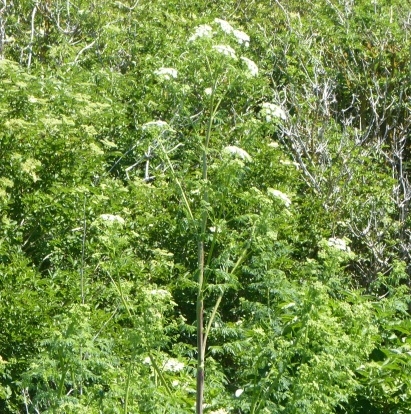
The main islands were
crammed with Black-headed Gulls nesting
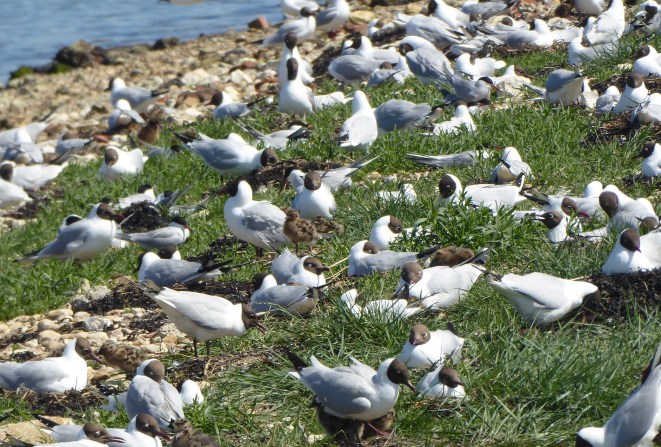
many family groups
with young chicks
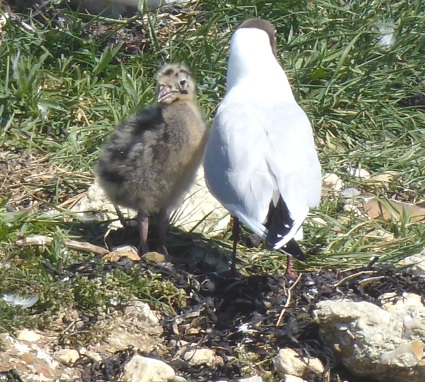
I could hear
Mediterranean Gulls calling, but did not spot any on
the islands, though I did not have my scope with me. I
did notice a pair of Oystercatchers at the
right hand end of the main island. I recall a pair
always tried to nest there when I was warden, often
not successfully.

I was interested to
see two tern rafts in the lagoon, the larger one on
the right has been there for several seasons, but the
smaller one on the left is new to me.

A notice indicated the
great impact the rafts have had since the first was
introduced in 2014. Numbers of Common Terns nesting
rose from 4 in 2016 to 79 last year!

Common Terns were
visible on both rafts, though the smaller one appeared
to have more nesting as shown here.
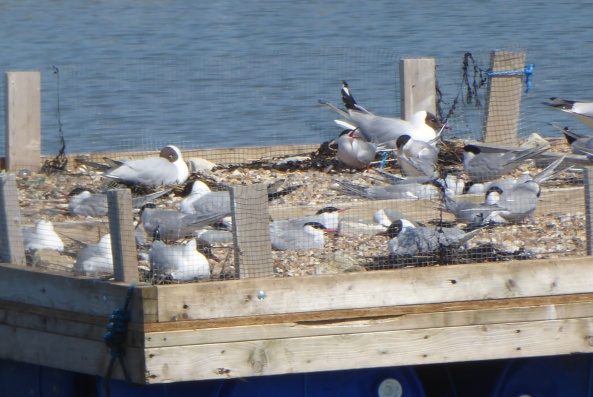
There was lots of
activity while I was there with Terns and Gulls
constantly coming and going with food for youngsters.
I managed to get a photo of a Common Tern that came
close to the shore where I was standing with a fish in
its bill.

I always used to take
an interest in plants and butterflies during my
wardening sessions. Today, I particularly pleased to
see some Small Heath butterflies, the first I
have seen since my wardening period. Small Heath is a
rare butterfly on Brook Meadow - the last one I
recorded was in 2010. This small brown butterfly,
always settles with its wings closed but its 'eye' is
conspicuous when its forewing is held aloft as in this
photo. I love the slightly furry underwing.
Some flowering plants
noted this morning were Weld, Bird's-foot Trefoil,
Bladder Campion (or is it Sea Campion?) and
Goat's-beard.
I was pleased to see
the patch of Divided Sedge had survived on the
main Billy Line
where the path goes off to the lagoon.
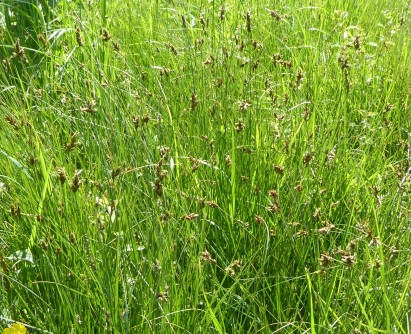
I happened to meet a
team of people from Diabetes Research picking
litter along the shoreline.
Three of them posed for a photo.

Finally, the old
'bus shelter' still survives, just. The metal
structure remains, but most of the window covering has
gone. I spent many hours in this little cranny,
sheltering from wind and rain, so I could not resist
doing a little selfie for the memory.
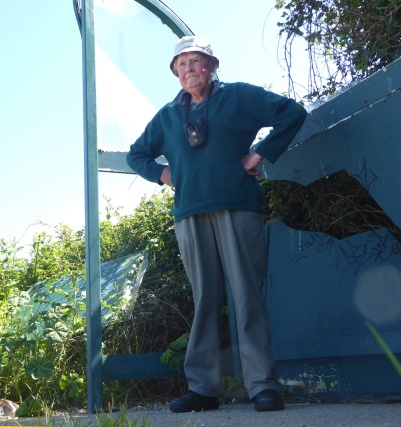
Langstone
Mill Pond
Peter
Milinets-Raby spent an hour this morning down
Langstone Mill Pond from 9am - low tide.
The highlight was my first 2 Swifts of the year flying
briefly over the pond. The other highlight was a
string of 8 tiddly Mallard ducklings (probably fresh
out this morning). Ridiculously cute!!!
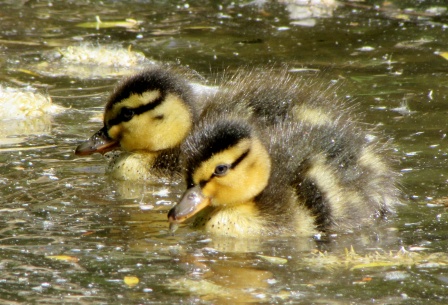
Other birds of note
included a pair of Tufted Duck, 1 Buzzard being mobbed
by a Carrion Crow, 2 Med Gulls over, 2 singing Reed
Warblers, another female Mallard with 4 growing
ducklings and the first two juvenile Little Egrets.
They were quite old looking (two plus weeks) and in
the main Holm Oak, probably from a nest deep within
the oak. There were in total, 21 obvious white blobs
in the trees, with probably more hidden away.
Off shore were 2 Common Tern, 4 Shelduck and 2
Oystercatchers. Very little else.
MONDAY
MAY 20 - 2019
Brook
Meadow
The first
Common Spotted Orchid of the year (with spotted
leaves) is just starting to open its flowers on the
orchid area on north meadow. This is a few days
earlier than in previous years. There should be more
to come both here and on the Lumley area. Last year we
had a record 25 in flower.
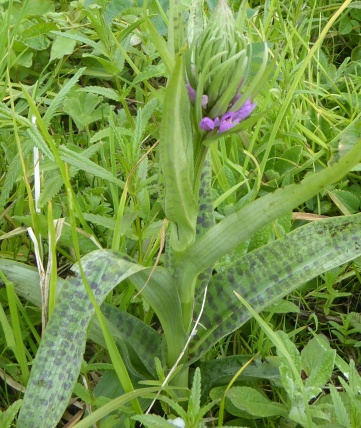
I counted a total of
13 Southern Marsh Orchids - 6 on the main
orchid area and 7 on the Lumley area. Let's hope we
can improve on last year's record of 103.
Yellow Rattle
is now flowering on both the orchid area and the
Lumley area. I believe seed was only sown on the main
orchid area, but the plants have spread to the Lumley
area as well.
While on the Lumley area I did another count of the
Ragged Robin and got to 154. I suspect we are
not going to get anywhere near the 433 that I counted
last year. Nevertheless it should be a reasonable
number.
The first Rough
Meadow-grass (with long ligules) of the year is
now out mainly in Palmer's Road Copse, but also
elsewhere on the meadow. Smooth Meadow-grass is always
far more difficult to find on the meadow.
The observation
fence which had been vandalised some time ago has
now been repaired by the Council with two struts, but
the green wire netting has not been replaced.
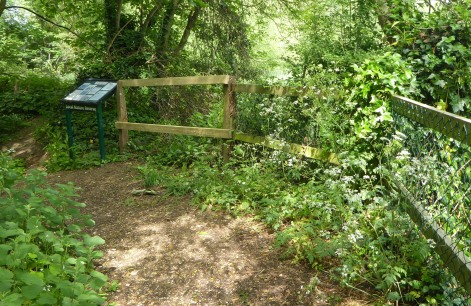
Hedgehog
in Garden
The trail
camera showed one Hedgehog visitor last night eating
up the small sprinkling of mealworms. It first arrived
at 21.51 and was around on and off until the last
sighting at 03.44.

Chichester
Peregrines
The Peregrines
are nesting again on Chichester Cathedral and have
hatched four chicks. Due to the scaffolding around the
cathedral to allow renovation of the roof the RSPB do
not have their usual viewing area in the Cloisters
Cafe garden. However, you can watch everything that
happens in the nest on the live webcam as usual. There
is a link on David Shaw's excellent web site . . .
https://www.chichesterperegrines.co.uk/
Great
Black-backed Gulls
This morning
at 9am, Peter Milinets-Raby ventured down to Peter
Pond and Slipper Mill Pond to mainly grab some photos
of the Great Black-backed Gull chicks. Peter's report
follows with some great photos . . .
"Like you reported on
your blog the female bird did some half speculative
dives at me as I walked passed, before she alighted on
one of the nearby chimneys, where she kept a very
beady eye on me. The male then came out of nowhere and
again half-heartedly dive bombed me a couple of times
before he landed on the raft, where he really did give
me the eyeball. The chicks were nowhere to be
seen.
A huge Great
Black-backed Gull diving at you initially is quite a
scary sight, especially from a great height, however
about 15 metres away they pull out of their dives to
semi hover above your head, calling aggressively. This
standoff of the female on the chimney and the male on
the raft lasted 50 minutes before eventually the male
called the chicks out from their hiding place to feed
them.
See photos and a short video
at:
https://www.youtube.com/watch?v=Ma2WqLWQv50
Initially the male was
just sort of controlled vomiting/emitting some juice
of his stomach contents and delicately feeding it to
the two chicks.
Then after 10 minutes
he regurgitated a hefty chuck of fish/squid to the
floor of the raft, where the chicks pecked at it. He
helped tear off bits for them. Then after about
another ten minutes he swallowed the chunk of
fish/squid and flew off. A great 20 minutes of
birding!"
For
the history of these fine birds nesting on Slipper
Millpond for the past 8 years
see . . . Great
Black-backed Gulls on Slipper Millpond
Other species of
note:
Peter Pond - Cetti's Warbler singing along with
a Reed Warbler. The 2 Canada Geese were present for a
short while before they flew off south.
Slipper Mill Pond - Two singing Reed Warblers
(in two tiny patches of reeds), a Med Gull over, Mute
Swan pair with 4 cygnets and a couple of Swallows over
the pond and showing a little interest in the Caravan
park area (the number of Swallows seen April/May now
rises to 16 - The graph still shows a overall general
decrease"
Summer
visitors
Peter
Milinets-Raby sends a couple of graphs showing clearly
how one particular summer migrant (Swallow) in the
Warblington/Emsworth area has declined.
The graph below shows
per year the number sightings of Swallow divided into
the number of visits to the Warblington/Emsworth area
during the months of April and May per year. On
average this has been around 24 visits during these
two months.

The graph below shows
the total number of Swallows seen per year in April
and May. This year (so far) I have only seen 14 birds
during 20 visits.

I'm sure if I did the
exercise for other species (Chiffchaff etc.) I would
get similar results.
Bucking the trend are Whitethroats, Blackcaps and Reed
Warblers. These seem to be holding their numbers in
the area, though I think Whitethroat is slight more
abundant over the last few years.
However, our area (Warblington/Emsworth) does not have
many summer migrants breeding in the first place.
Numbers of summer migrants passing through the area
have definitely declined (House Martin and Swift are
obvious species).
We just happen to live in a poor area generally for
breeding summer migrants, so it is very easy to
observe the decline (House Martins and Swifts are a
good example).
SATURDAY
MAY 18 - 2019
Starlings
Everyone seems
to have Starlings in their garden at present with
youngsters constantly begging for food. Keith Wileman
liked this photo he got of the backs of the three
birds. As he says, "The adult looks as if it's wearing
a cloak and you can clearly see how the pattern is
going to develop on the young ones".

Spiderlings
Brian Lawrence
was on Brook Meadow yesterday and got this picture of
a nest of emerging spiderlings of the common Garden
Spider (Araneus diadematus). The eggs
were laid in the autumn by the female which spins a
cocoon around them to protect them over the winter.
The spiderlings emerge in the spring and gather into
dense groups, as in Brian's photo, before dispersing
by 'ballooning' in which they are carried on the wind
by a thread of silk, and so begin the process of life
again.

FRIDAY
MAY 17 - 2019
Great
Black-backed Gull chicks
The big news
from the millponds is that the Great Black-backed
Gulls have hatched at least two chicks on Slipper
Millpond. I was alerted to their likely presence as I
walked slowly along Slipper Road by the somewhat
frenzied activity of a guarding parent who flew
squawking over my head several times as I approached
the nest area. I have been similarly 'buzzed' by these
magnificent birds in the past, a scary experience
indeed! It flew around the pond and perched high on
one of the chimneys in Slipper Road. I could not see
the chicks very well on the raft, but could clearly
make out two, but no more.
For
the full history of the nesting of these large gulls
go to . . .
Great
Black-backed Gulls on Slipper Millpond
The Mute Swan family with their 4 small cygnets was on
the east bank of Slipper Millpond.

Over on Peter Pond the
Canada Goose pair were back on the raft, but not
nesting.

Hedgehogs
in garden
The trail
camera picked up two Hedgehogs on the patio last
night. They arrived just after 11pm and stayed around
for about an hour picking up bits of mealworms I had
scattered around. There was no mating behaviour this
time!

Wordsworthian
Crow
Juliet Walker
loved the description of the Carrion Crow in
yesterday's workday report of appreciating the
buttercups in 'almost Wordsworthian fashion'.

It prompted her to pen
the following poetic response (with apologies to WW) .
. .
I wandered lonely -
as a crow -
That stalks about while folks clear up
When all at once I saw a show,
A host, of golden buttercups;
Beside the Ems, amongst the grass,
Fluttering and dancing as I pass.
Juliet added she might
have done the rest of the verses, but that would have
taken all day at least! Maybe another time ...
Yes please Juliet!
Peter's
Video
Peter
Milinets-Raby has spent the last few days wandering
around Warblington dreaming of better places to go
bird watching (while miming to Matt Munroe). His film
entitled 'Somewhere' is very beautiful and tranquil.
Worth watching. Nice one, Peter.
See the film at . . . https://www.youtube.com/watch?v=2gZMyMEbWOM
Peter's report
. . . This
morning, I was out again for another 48 minutes of
near utter tedium on a visit to Langstone Mill Pond
from 9am. At least the Heronry provided some
excitement. The Grey Heron Nest 14 has possibly 3
growing chicks. The Little Egrets were still sitting -
must be any day now that chicks will hatch. The Mute
Swan nest - they must be due to hatch soon as
well!
Other
birds of note were a pair of Tufted Duck, a pair of
Gadwall, 4 Reed Warblers, 2 singing Blackcap, a single
Swallow over and 3 Med Gulls. On the last patch of mud
before it was covered were a migrating group of 4
Dunlin and 13 Ringed Plovers. Also in the channel were
11 Shelduck and 2 Common Tern.

Not
much else I'm afraid, especially for the second week
of May!! This must be the worst spring on record. I
think in five years time (When the World laments the
loss of so many summer visitors), we will look back on
this year and realise that this year was the official
start of Global Warming and we should have seriously
done something about it! I think it is getting a wee
bit late to rescue the World! Gloom!
For
earlier entries go to . . . May
1-16